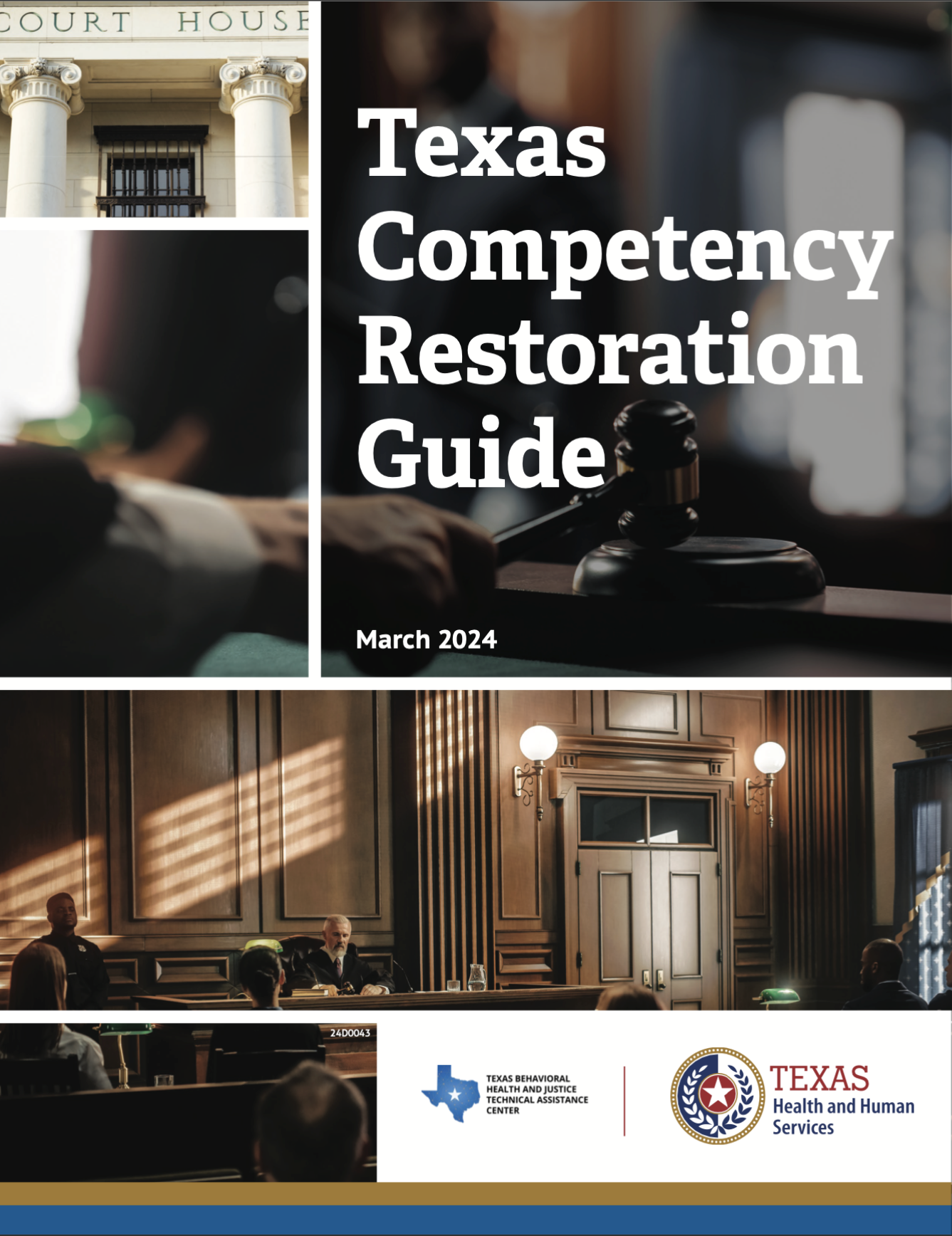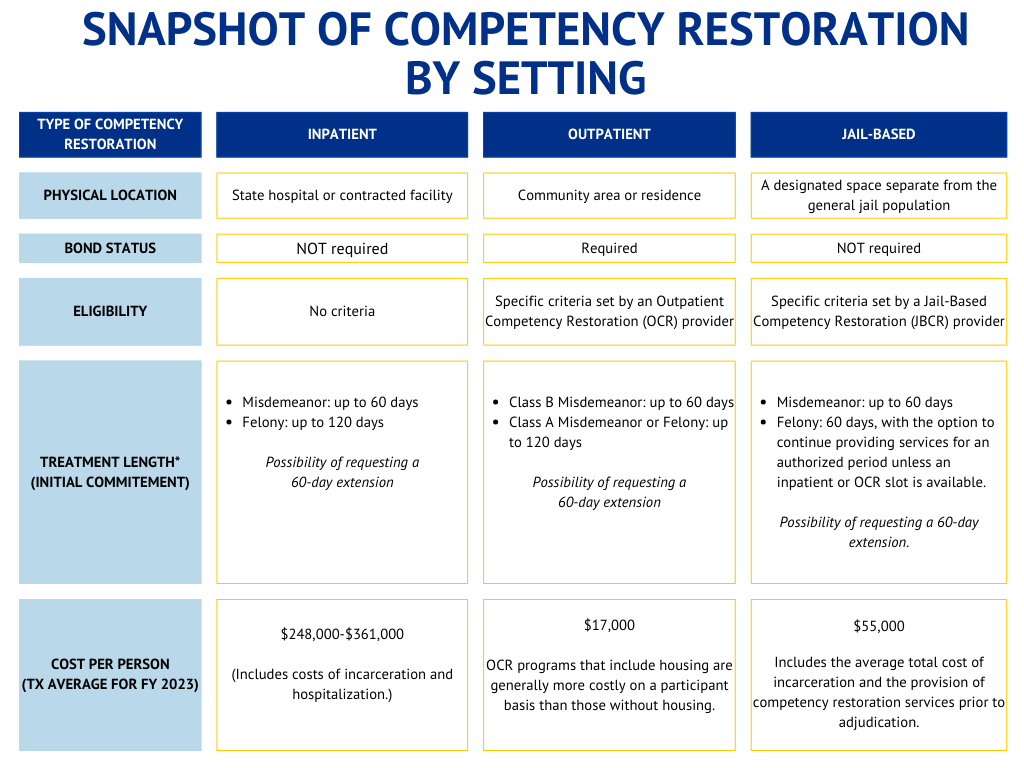*The time lengths of treatment are based on Texas Code of Criminal Procedure articles 46B.073, 46B.0711, 46B.072, 46B.080 and 46B.091.
Texas Competency Restoration Guide
The Competency Restoration Guide provides an overview of the competency restoration process, a set of principles to support a more efficient and effective system, and supplemental guidance to determine the most appropriate competency restoration (CR) placement.
Competency restoration is the process of providing treatment and education to people who have been found incompetent to stand trial to help them participate in their defense. The CR process is designed to protect the rights of people with mental illness or an intellectual or developmental disability who are charged with a crime.
A person may be found incompetent to stand trial (IST) if they don’t have (1) sufficient ability to consult with their lawyer with a reasonable degree of rational understanding or (2) a rational and factual understanding of the proceedings against them.
The competency to stand trial process begins when the prosecution, defense or trial court raises the issue of a person’s competency. If a person is found IST, the court may dismiss the charges against the person or pause court proceedings and order a competency evaluation.
If the court orders a competency evaluation and the person is found IST, the court can order CR services to stabilize symptoms of mental illness and provide legal education. Interventions used to restore competency may include psychotropic medications, legal education about the proceedings, and specialized or individualized treatments.
Principles of Competency Restoration
Judges, lawyers, mental health clinicians, law enforcement, family and other community members can support an effective and efficient CR system. These principles are suggestive rather than prescriptive and within the context of services and support available in a community.
Principle One: Access to robust, appropriate, and timely community-based services and support is essential to divert people with mental illness from the criminal justice system and to promote reentry after a period of incarceration. This is the foundation for reducing the number of people determined IST who need competency restoration.
Principle Two: People for whom the compelling interest to prosecute is low are not considered for competency restoration. People for whom the compelling interest to prosecute is high receive competency restoration services in the least restrictive setting as appropriate.
Principle Three: Competency Restoration is used only to stabilize symptoms of mental illness and provide legal education to allow for the resumption of the adjudicative process.
Principle Four: The competency restoration system provides clear accountability for systematic efficiency, equity, quality evaluators and evaluations, and is committed to confidentiality.
Principle Five: The competency restoration system emphasizes early identification and intervention, matching the services provided to the person’s needs, and ensures continuity of services and support for people moving between treatment setting.
Principle Six: The competency restoration system is defined by strong collaboration among mental health providers, law enforcement, jail administration, prosecutors, defense attorneys, the judiciary, and all three branches of state and local government.
Principle Seven: Partners involved in the competency restoration process observe and promote appropriate and statutorily required timelines for tasks that fall within their respective domains.
Principle Eight: Partners implement data-driven decision-making processes, to include a data collection, analysis, and dissemination strategy.
Principle Nine: Partners are knowledgeable about the competency restoration process, including the sequence of events, terminology, and processes.
Principle Ten: Competency restoration placement decisions are guided by research, data, statute, administrative rule, and the best available tools to support decision-making that consider legal severity, clinical acuity, and risk of recidivism.
Restoration Placement
Competency Restoration Placement Decision-Tree
The Competency Restoration Placement Decision-Tree helps judges, lawyers, and mental health clinicians identify and prioritize the various factors that determine the best available CR placement for people who are IST. This tool is suggestive rather than prescriptive and used within the context of services and support available in a community.
Supplemental Guidance for Competency Restoration Placement Decision Tree
The below guidance provides additional explanation or clarification for certain steps in determining the most appropriate CR placement, as indicated by the number inside the yellow circles within the graphic.
1 - Compelling Interest to Prosecute, Class B Misdemeanors. Texas Criminal Code of Procedure articles 46B.0711, 46B.072 and 46B.073 may require certain placements if the person is charged with a Class B misdemeanor.
2 - Evidence of Neurocognitive Disorders (NCDs) and Traumatic Brain Injuries (TBIs). NCDs include a group of conditions previously classified as dementia that manifest as declines in attention, executive function, learning, memory, language and social cognition. TBIs may impact brain functioning and cognition. Restoration may or may not be likely for people with NCD or TBI.
3 - Repeat IST Patients. People who have received CR services in the past and are determined unlikely to benefit from them are less likely to benefit from subsequent services. In these cases, partners should consider the fiscal implications to local and state systems and the health and legal impacts to an individual before pursuing CR services.
4 - Substance Use Disorders. People with a primary diagnosis of a substance use disorder (SUD) who are charged with a substance-related offense may be better served in a setting that can provide robust SUD treatment, whether in an inpatient or outpatient setting.
5 - Outpatient Competency Restoration Services. These are best for a person who is IST and in the community on bond.
6 - Risk Assessment Tools. Clinicians should use validated and reliable assessment tools to measure violence and criminogenic risks. See the Bureau of Justice Assistance’s Public Safety Risk Assessment Clearinghouse for more information on criminogenic risk assessment instruments.
7 - Legal Severity and Community Impact. Considerations of legal severity and community impact may include violence and risk of recidivism, the nature of the offense, the severity of the offense, and the potential impact to public safety if the person returns to the community.
8 - Transitioning to Least Restrictive Setting. People committed to inpatient competency restoration may be able to transition to an alternative setting if they are clinically ready and can be safely transferred to outpatient or jail-based CR.





